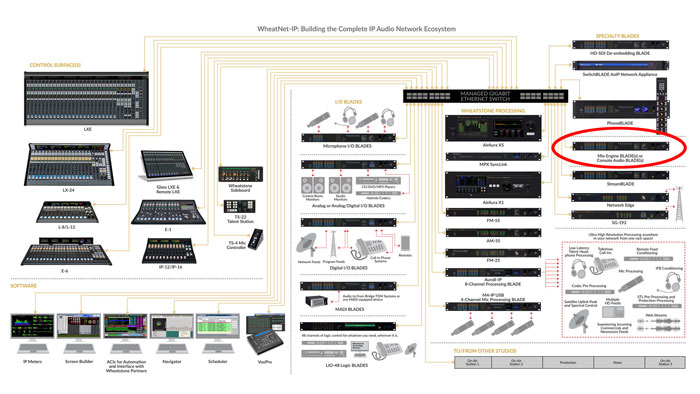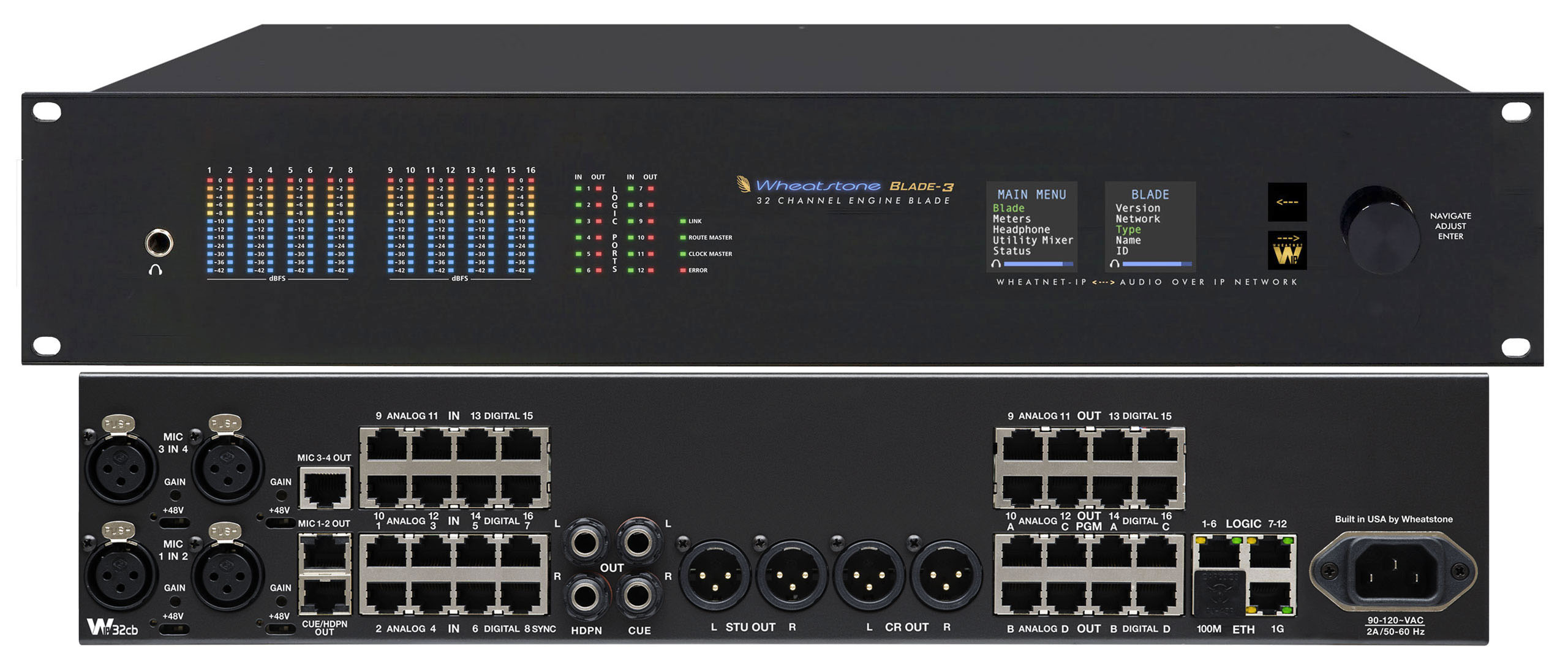
Mix Engine BLADES: The Power Plants Behind the WheatNet-IP Network
Every nerve center needs a brain. Every city needs a source of power. For Wheatstone control surfaces, the Mix Engine BLADE-3s are it.
Unique to Wheatstone’s console engine approach is its true IP connectivity. The control surfaces connect directly into the network switch itself, giving them access to mix engine functions as well as direct access to automation systems, network applications and other control surfaces that make true system interoperability possible. The mix engines can live anywhere on the network, such as your TOC room, so no worries about cramming them into already-tight studio space.
Other IP audio systems tie the control surface and the console engine together using CAN bus, thereby filtering all outside communications through the console engine first and isolating the control surface from other elements and functions in the network.
A Mix Engine BLADE-3 houses all the DSP power for an individual radio control surface and distributes the stereo PGM buses, stereo AUX sends, per-channel mix-minus feeds, monitor outputs, and other bus signals to the network. Once on the network, bus signals are available as sources and destinations anywhere. This creates an extremely flexible system in which program outputs from one surface can be sources on any other surface; for example, a news mixer’s program bus can be brought up as a source on the air studio surface. They are AES67 compatible for use with other AES67-compatible devices and signals in the WheatNet-IP Intelligent Network.
While standard BLADE Mix Engines don’t house audio I/O, they do include 12 universal logic (GPIO) ports for interfacing various external switches, indicators and devices for control purposes. Our Console Audio BLADEs are Mix Engines that DO have I/O built in. And our Audioarts Mix Engine for the DMX console also provides I/O as well as a 5-port switch for installation in smaller facilities.
|
Gigabit Connectivity Virtually All Audio Formats Two 8x2 Utility Mixers Audio & Control Routing Matrix Source & Destination Control Dual OLED Displays Silence Detection Built-in Audio Clip Player Front Panel Logic Indicators 12 Universal GPI/O Ports 128 Software Logic Ports LIO/SLIO Logging Stereo Audio Processor Associated Connections Aliases AES67 44.1, 48K, External Sync or AES67 Operation Clock/Sync Indicators Onboard Intelligent OS 44.1K or 48K Sampling Rates | | |
Auto Mono Summing Signal Splitting Gain Control on Every Input & Output Balance Control Flexible Signal Configuration Studio Bypass Front Panel Input and Output Metering Front Panel Headphone Jack and Source Selection Salvos/Macros Automation Control Interface (ACI) Screen Builder SNMP Connection Choices Info Screen LIO Test Backup Alarm Notification NTP Front Panel Locking Version Checker Crosspoint Save Debugging No Cooling Fans
Specific Functions for Specific BLADES: Mic Processor Eight Audio Processors High Density Ingest External Clock Reference |
|---|
Mix Engine BLADE-3s
MIX ENGINE BLADE-3s FEATURE:
-
True IP connectivity: Includes DSP processing
-
12 universal logic ports (GPIO) on 2 RJ-45 connectors
-
AES67 compatible
-
Front panel headphone jack
-
OLED front panel display with graphical menu
-
One Gigabit Ethernet port
Mix Engine BLADEs are required for all Wheatstone IP consoles and are available in specific configurations for each. Console Audio BLADEs (see above) combine I/O and Mix Engine for our smaller consols for use in compact installations where extensive I/O is not required. For mid to larger installations, the mix engine is either included with the console or purchased separately, allowing you to tailor the I/O to your specific requirements.
IP88-3 E (for use with E-6, LX-24):
DSP processing, 12 universal logic ports (GPIO) on 2 RJ-45 connectors, front panel headphone jack, gigabit Ethernet port
IP88-3 LXE (for use with LXE, Glass LXE):
DSP processing, 12 universal logic ports (GPIO) on 2 RJ-45 connectors, extra Ethernet connector, 2 USB connectors, 1 HDMI connector, front panel headphone jack, gigabit Ethernet port
Console Audio BLADE-3s
Console Audio BLADE-3 Features:
-
True IP connectivity
-
24-bit A/D and D/A convertors
-
12 Universal Logic ports (GPIO) on 2 RJ-45 connectors
-
Integrated I/O Mix Engine BLADE
-
AES67 Compatibility
-
Cue and headphone outputs on RJ45 and 1/4” jack*
-
Control room and studio monitor outputs on XLRs*
-
OLED front panel displays with graphical menu
-
Gigabit Ethernet port
Standard 1RU Enclosure:
2 Mic Preamps with phantom power and gain trim w/ XLR inputs
4 Stereo (8 Mono) Analog Line inputs on RJ-45
4 AES inputs on RJ45
4 Stereo (8 Mono) Analog Line Outs on RJ45
4 AES Outputs on RJ45
CB32 2RU Enclosure:
4 Mic preamps with phantom power and gain trim w/ XLR inputs
8 Stereo (16 Mono) analog line inputs on RJ-45
8 AES inputs on RJ45
8 Stereo (16 Mono) analog line outs on RJ45
8 AES outputs on RJ45
* NOTE: Control Room, Studio, Cue and Headphone outputs are part of the total of AES and stereo analog outputs. These may be reassigned for use as other outputs as desired.
Console Audio BLADE-3s provide audio I/O and DSP mix engine functions for WheatNet-IP radio control surfaces (see Gibraltar Mix Engine for TV Consoles) through the network switch.
Console Audio BLADE-3s come standard with L-8, L-12, E-1, IP-12 and IP-16 control surfaces. A single Console Audio BLADE-3 is all that is needed for some studio operations, but busy studios often require an additional I/O BLADE-3 or Wheatstone’s CB32 model which doubles the amount of I/O in 2RU.
All Console Audio BLADEs are AES67 compatible to bring audio from other AES67-compatible devices and signals into and out of the WheatNet-IP Intelligent Network.
There are four types of Console Audio BLADE-3s:
IP88-3 CB (for use with IP-12/IP-16):
8 mono (4 stereo) analog line inputs, 2 mic preamps (patchable to 2 analog line inputs), 4 AES inputs, 4 AES outputs, 4 analog outputs, cue and headphone outputs on RJ45 and 1/4" jacks, control room and studio monitor outputs on XLRs, 12 programmable logic ports.
IP88-3 CBE (for use with E-1):
8 mono (4 stereo) analog line inputs, 2 mic preamps (patchable to 2 analog line inputs), 4 AES inputs, 4 AES outputs, 4 analog outputs, cue and headphone outputs on RJ45 and 1/4" jacks, control room and studio monitor outputs on XLRs, 12 programmable logic ports, EQ and dynamics processing on every fader channel
IP88-3 CBL (for use with L-8/L-12):
8 mono (4 stereo) analog line inputs, 2 mic preamps (patchable to 2 analog line inputs), 4 AES inputs, 4 AES outputs, 4 analog outputs, cue and headphone outputs on RJ45 and 1/4" jacks, control room and studio monitor outputs on XLRs, 12 programmable logic ports
IP32-3CBL OPTIONAL DOUBLE I/O (for use with IP-12/IP-16, L-8/L-12):
16 mono (8 stereo) analog line inputs, 4 mic preamps (patchable to 2 analog line inputs), 8 AES inputs, 8 AES outputs, 16 analog outputs, cue and headphone outputs on RJ45 and 1/4" jacks, control room and studio monitor outputs on XLRs, 12 programmable logic ports
Audioarts Mix Engine
For use with AUIOARTS DMX Consoles
Audioarts Mix Engine uses RJ45 connectors for all audio (StudioHub+ format), logic (WheatNet-IP-format), and network connections, except for the 2 mic preamp inputs (XLR). Connections include Mic Preamps Out; 4 stereo/dual mono analog inputs; 4 stereo/dual mono digital inputs; four stereo Program outputs (both analog and digital); 4 stereo analog Monitor outputs (Control Room, Studio, Cue, and operator headphones); 6-port logic GPIO; Engine Ethernet port; 5-Port Ethernet switch to network the Surface, Engine, and three additional devices.









